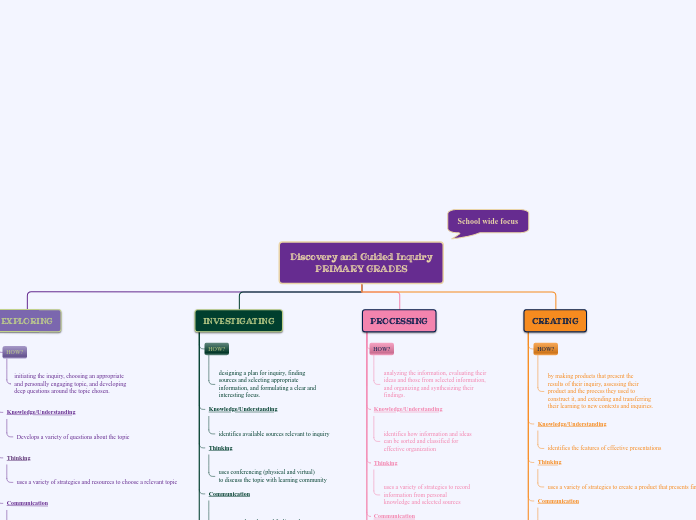Discovery and Guided Inquiry
PRIMARY GRADES
EXPLORING
HOW?
initiating the inquiry, choosing an appropriate
and personally engaging topic, and developing
deep questions around the topic chosen.
Knowledge/Understanding
Develops a variety of questions about the topic
Thinking
uses a variety of strategies and resources to choose a relevant topic
Communication
explains answers generated about the chosen topic, using a variety of
forms
Application
applies collaborative skills to help understand the purpose and
features of the inquiry
Activities
-Brainstorming with others about possible questions
W5H, matrixes,
virtual-google docs, Mindomo,
face-to-face: partner, small groups, role play
-Virtual Space to build Inquiry
Whole Class, Group Specific
Blog, Mindomo, Docs,
Assessment Tools
- checklists to detail purpose, nature, and timeline of assignment
- rubrics to establish criteria for effective inquiry
INVESTIGATING
HOW?
designing a plan for inquiry, finding
sources and selecting appropriate
information, and formulating a clear and
interesting focus.
Knowledge/Understanding
identifies available sources relevant to inquiry
Thinking
uses conferencing (physical and virtual)
to discuss the topic with learning community
Communication
expresses thoughts and feelings about
the inquiry process
Application
applies knowledge of how information
is organized to help locate and select
information
Activities
- Read and discuss visual information such as
pictures, graphs and illustrations
- Take "virtual field trips" (Skype with experts)
- Conference with learning partners and teacher
Assessment Tools
- organizers and templates to plan inquiry and record
information and sources
- rubrics to establish criteria for selecting information,
and formulating a focus
PROCESSING
HOW?
analyzing the information, evaluating their
ideas and those from selected information,
and organizing and synthesizing their
findings.
Knowledge/Understanding
identifies how information and ideas
can be sorted and classified for
effective organization
Thinking
uses a variety of strategies to record
information from personal
knowledge and selected sources
Communication
expresses thoughts and feelings
about analyzing ideas
Application
makes connections between personal
knowledge and new information
Activities
Use graphic organizers (e.g. T-chart,
Venn diagram, information map) to
compare information, according to
content or validity
Assessment Tools
- exemplars of a variety of forms and presentations
- rating scales for evaluating and comparing websites
CREATING
HOW?
by making products that present the
results of their inquiry, assessing their
product and the process they used to
construct it, and extending and transferring
their learning to new contexts and inquiries.
Knowledge/Understanding
identifies the features of effective presentations
Thinking
uses a variety of strategies to create a product that presents findings
Communication
expresses thoughts and feelings about presentation
Application
applies knowledge of exemplary practices to make effective products
and presentations
Activities
Use the most appropriate method to support and present findings while honouring the learner’s choice (e.g. visual, oral, performance, written, multimedia, digital).
Post a presentation on an established physical or virtual space to rehearse and test its effectiveness.
Assessment Tools
anecdotal records for recording reflections about the strengths and
challenges of the inquiry process used
checklists to chart possible topics, plans, and products for extending
the inquiry and transferring learning
